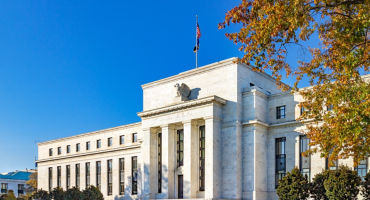- Fixed Income Portfolio Manager
Skip to main content
- Funds
- Insights
- Capabilities
- About Us
- My Account
United States, Institutional
Changechevron_rightThank you for your registration
You will shortly receive an email with your unique link to our preference center.
The views expressed are those of the author at the time of writing. Other teams may hold different views and make different investment decisions. The value of your investment may become worth more or less than at the time of original investment. While any third-party data used is considered reliable, its accuracy is not guaranteed. For professional, institutional, or accredited investors only.
Just two days after the tempestuous 2024 US election, The Federal Open Market Committee (FOMC) stayed its course, cutting its target policy rate range by 25 basis points (bps) — a decision consistent with market pricing heading into the meeting. Economic data has trended in the right direction to justify further policy accommodation, though the Fed will likely want to preserve some flexibility over the next couple of meetings as financial conditions evolve in response to the US presidential election outcome. In his post-meeting press conference, Powell declined to comment on potential policy shifts from the new Trump Administration, consistent with protocol. He did, however, vow to maintain independence regardless of any political pressure including requests for his dismissal.
The labor market has softened in response to past tightening of monetary policy and is probably close to the NAIRU (non-accelerating inflation rate of unemployment) that is coveted by Fed officials. Storms and strikes contributed to a weaker-than-expected payroll report in October, but the unemployment rate held steady at 4.1 percent, consistent with the range provided in the Fed’s most recent longer run projections. We continue to expect the unemployment rate to move higher over the coming quarters, but we recognize that the outlook for both labor supply and demand may change based on expected policy changes from the new Administration.
The progress on inflation has stalled somewhat, with the Fed’s preferred gauge — core personal consumption expenditures (PCE) –— printing at 2.7% last month, still stubbornly above the Fed’s 2% target. Services prices rose faster than goods prices and spending data continue to suggest a resilient consumer as the lagged impact of past Fed rate increases works through the economy. Recent revisions to US growth and income data (especially those to the National Income and Product Accounts from the Bureau of Economic Analysis) also suggest the consumer is probably in better shape than we expected based on prior data. The policy tightening has had a more acute effect on the housing market and the moderating of rental prices should continue to put downward pressure on inflation even if the Fed continues to ease policy as I expect.
President-elect Trump campaigned on restrictive immigration policy and higher tariffs; these policies could create a more inflationary environment in 2025. Markets have begun to price this risk; breakeven inflation rates (BEI) increased in recent weeks as Trump gained in the polls and shot higher after the election result. While it may take some time for any policy changes to work their way through the economy, expectations can eventually transition into reality. There is also precedent for the Fed to incorporate BEI in its assessment of the inflation outlook, and a further ascent may require an adjustment to monetary policy, possibly including rate hikes later next year if inflation and growth prove to be stronger than currently expected. When Powell was asked specifically about the possibility of hikes next year, he noted that they are not taking anything off the table at this point given the increased uncertainty surrounding the economic outlook.
The Fed faces a challenging road ahead. If inflation accelerates next year, the central bank may be inclined to guard against a wage price spiral by hiking policy rates. Fingers may then be pointed at the Fed should a material growth slowdown or recession ensue. Trump has been adamant in the past that the White House should play a larger role in setting monetary policy and there could be pressure to sway those decisions in 2025.
I am confident that Chair Powell will continue to conduct monetary policy with the pursuit of achieving the Fed’s mandate of stable prices and full employment, independent of any political influence. His current term ends in May 2026, at which point Trump will likely appoint a successor, subject to Senate approval. I’ll be watching to see whether those appointees are more politically motivated than academically oriented. While Republicans gained a majority in the Senate in this week’s elections, the outcomes of a few races have yet to be decided. Those results could have important implications for not only the next Fed Chair, but the future ideology of the FOMC.
Expert

Related insights
Weekly Market Update
Continue readingBy
FOMC: Easing into uncertainty
Continue readingOpportunity ahead: Optimism or illusion?
Continue readingFinancing the AI boom: credit markets at a crossroads
Continue readingLow tide, sharp eyes: What to pick up
Continue readingFinding durable value amid shifting currents
Continue readingURL References
Related Insights
Stay up to date with the latest market insights and our point of view.
Thank you for your registration
You will shortly receive an email with your unique link to our preference center

Weekly Market Update
What do you need to know about the markets this week? Tune in to Paul Skinner's weekly market update for the lowdown on where the markets are and what investors should keep their eye on this week.
By

FOMC: Easing into uncertainty
Fixed Income Portfolio Manager Jeremy Forster profiles the Fed's December rate cut, labor market trends, inflation pressures, and the role of anticipated changes to FOMC leaders in 2026.

Opportunity ahead: Optimism or illusion?
Explore our latest views on risks and opportunities across global capital markets.

Financing the AI boom: credit markets at a crossroads
Fixed Income Portfolio Manager Derek Hynes and Fixed Income Investment Specialist Will Prentis examine how the AI financing boom is transforming credit markets and discuss the opportunities and risks it creates for investors.

Low tide, sharp eyes: What to pick up
Fixed Income Managers Campe Goodman and Rob Burn share their outlook for credit in 2026 and discuss how investors can reposition for an environment where opportunities are harder to find.

Finding durable value amid shifting currents
Fixed Income Strategist Amar Reganti and Investment Director Marco Giordano explore how to approach bond investing in 2026. They see durable value for investors who can flexibly adjust to the shifting currents ahead.

Monthly Market Review — October 2025
A monthly update on equity, fixed income, currency, and commodity markets.

Investing in 2026: prepare for inflationary growth
Macro Strategists John Butler and Eoin O'Callaghan share their annual macro outlook and discuss likely implications for markets and investors. They outline four potential scenarios graded by level of probability.

Rapid Fire Questions with Ross Dilkes
In this edition of “Rapid Fire Questions,” fixed income portfolio manager Ross Dilkes shares his views on the Asia credit market—covering the macro outlook, China’s momentum, the most compelling opportunities across the region, and key risks shaping the next 12 months.

Constructive, selective, resilient
Amar Reganti, a member of our Insurance team, explains why he believes insurers should remain selectively risk-on while prioritizing high-quality income and preserving flexibility to add risk as valuations improve.
By

Questioning US credit quality
Fixed income strategist Amar Reganti examines questions surrounding US creditworthiness.
By
URL References
Related Insights
© Copyright 2025 Wellington Management Company LLP. All rights reserved. WELLINGTON MANAGEMENT ® is a registered service mark of Wellington Group Holdings LLP. For institutional or professional investors only.
Enjoying this content?
Get similar insights delivered straight to your inbox. Simply choose what you’re interested in and we’ll bring you our best research and market perspectives.
Thank you for joining our email preference center.
You’ll soon receive an email with a link to access and update your preferences.
Monthly Market Review — October 2025
Continue readingBy